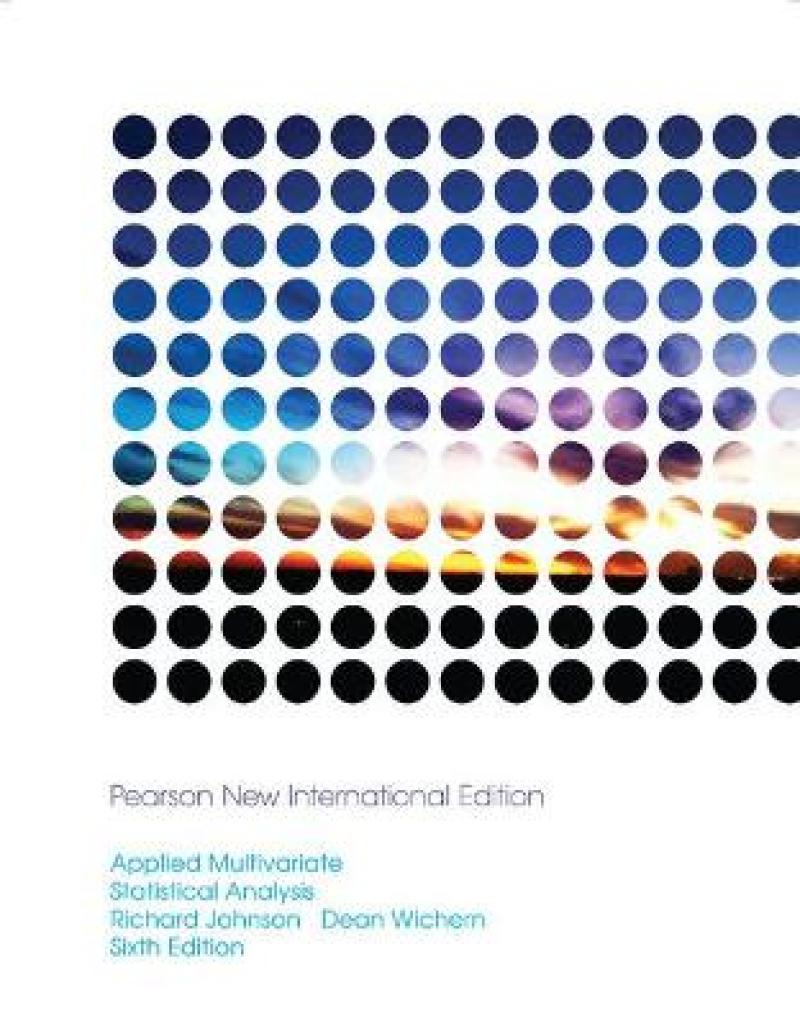For courses in Multivariate Statistics, Marketing Research, Intermediate Business Statistics, Statistics in Education, and graduate-level courses in Experimental Design and Statistics.
Appropriate for experimental scientists in a variety of disciplines, this market-leading text offers a readable introduction to the statistical analysis of multivariate observations. Its primary goal is to impart the knowledge necessary to make proper interpretations and select appropriate techniques for analysing multivariate data. Ideal for a junior/senior or graduate level course that explores the statistical methods for describing and analysing multivariate data, the text assumes two or more statistics courses as a prerequisite.
DRAFT
(NOTE: Each chapter begins with an Introduction, and concludes with Exercises and References.)
I. GETTING STARTED.
1. Aspects of Multivariate Analysis.Applications of Multivariate Techniques. The Organization of Data. Data Displays and Pictorial Representations. Distance. Final Comments.
2. Sample Geometry and Random Sampling.
The Geometry of the Sample. Random Samples and the Expected Values of the Sample Mean and Covariance Matrix. Generalized Variance. Sample Mean, Covariance, and Correlation as Matrix Operations. Sample Values of Linear Combinations of Variables.
3. Matrix Algebra and Random Vectors.
Some Basics of Matrix and Vector Algebra. Positive Definite Matrices. A Square-Root Matrix. Random Vectors and Matrices. Mean Vectors and Covariance Matrices. Matrix Inequalities and Maximization. Supplement 2A Vectors and Matrices: Basic Concepts.
4. The Multivariate Normal Distribution.
The Multivariate Normal Density and Its Properties. Sampling from a Multivariate Normal Distribution and Maximum Likelihood Estimation. The Sampling Distribution of `X and S. Large-Sample Behavior of `X and S. Assessing the Assumption of Normality. Detecting Outliners and Data Cleaning. Transformations to Near Normality.
II. INFERENCES ABOUT MULTIVARIATE MEANS AND LINEAR MODELS.
5. Inferences About a Mean Vector.The Plausibility of …m0 as a Value for a Normal Population Mean. Hotelling's T 2 and Likelihood Ratio Tests. Confidence Regions and Simultaneous Comparisons of Component Means. Large Sample Inferences about a Population Mean Vector. Multivariate Quality Control Charts. Inferences about Mean Vectors When Some Observations Are Missing. Difficulties Due To Time Dependence in Multivariate Observations. Supplement 5A Simultaneous Confidence Intervals and Ellipses as Shadows of the p-Dimensional Ellipsoids.
6. Comparisons of Several Multivariate Means.
Paired Comparisons and a Repeated Measures Design. Comparing Mean Vectors from Two Populations. Comparison of Several Multivariate Population Means (One-Way MANOVA). Simultaneous Confidence Intervals for Treatment Effects. Two-Way Multivariate Analysis of Variance. Profile Analysis. Repealed Measures, Designs, and Growth Curves. Perspectives and a Strategy for Analyzing Multivariate Models.
7. Multivariate Linear Regression Models.
The Classical Linear Regression Model. Least Squares Estimation. Inferences About the Regression Model. Inferences from the Estimated Regression Function. Model Checking and Other Aspects of Regression. Multivariate Multiple Regression. The Concept of Linear Regression. Comparing the Two Formulations of the Regression Model. Multiple Regression Models with Time Dependant Errors. Supplement 7A The Distribution of the Likelihood Ratio for the Multivariate Regression Model.
III. ANALYSIS OF A COVARIANCE STRUCTURE.
8. Principal Components.Population Principal Components. Summarizing Sample Variation by Principal Components. Graphing the Principal Components. Large-Sample Inferences. Monitoring Quality with Principal Components. Supplement 8A The Geometry of the Sample Principal Component Approximation.
9. Factor Analysis and Inference for Structured Covariance Matrices.
The Orthogonal Factor Model. Methods of Estimation. Factor Rotation. Factor Scores. Perspectives and a Strategy for Factor Analysis. Structural Equation Models. Supplement 9A Some Computational Details for Maximum Likelihood Estimation.
10. Canonical Correlation Analysis
Canonical Variates and Canonica
- Twelve new real data sets (e.g. National track records for men andwomen, Psychological profile data, Car body assembly data, Concho water snake data, Stock price data, Census track data, Mali family farm data and others.)
- Thirty seven new exercises and twenty revised exercises (Most of new and revised exercises based on new data sets.)
- Four new examples and fifteen revised examples (New and revised examples based on new data sets or theoretical concepts new to this edition.)
- Six new or expanded sections (e.g. Section 6.6 Testing for Equalityof Covariance Matrices, Section 11.7 Logistic Regression and Classification, Section 12.5 Clustering Based on Statistical Models, Expanded Section 6.3 to include “An Approximation to the Distribution of T2 for Normal Populations When Sample Sizes are not Large,” Expanded Sections 7.6 and 7.7 to include Akaike’s Information Criterion, Expanded Section 12.8 to include material on new biplots.
- Consolidated old sections 11.3 and 11.5 on two group discriminant analysis into single section 11.3.
- To make the text more easily accessible to a wider audience who need to use the methods of applied multivariate analysis, we have removed several long proofs and placed them on the website.
- All data sets are available on the website for easy accessibility
Produktdetaljer
Biografisk notat
Dean W. Wichern is Professor Emeritus at the Mays School of Business at Texas A&M University. He holds membership in the American Statistical Association, Royal Statistical Society, International Institute of Forecasters, and Institute for Operations Research and the Management Sciences. He is the author for four textbooks and was Associate Editor of Journal of Business and Economic Statistics from 1983-1991.
Professor Richard A. Johnson is Professor in the Department of Statistics at the University of Wisconsin. He is a Fellow of the Institute of Mathematical Statistics and the American Statistical Association and he is amember of the Royal Statistical Society and International Statistical Institute. He is the author of six textbooks and over 120 technical publications and is the founding Editor of Statistics and Probability Letters (1981-).
